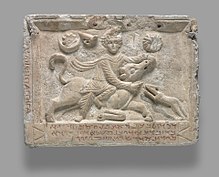Mithraeum of Dura Europos
The mithraium of Dura Europos was found during excavations in this city in 1934. It is considered to be one of the best-preserved and best-documented cult buildings of its kind.
The temple is located in the northwest of the city, near the city wall. It is a free-standing building made of adobe bricks. The execution of the masonry is described in the preliminary report as rather poor. There are three construction phases. At the beginning it was a cult room built into a residential building, which was expanded and decorated over and over again. The temple is at ground level. The inside resembles a basilica . These are rather atypical elements for Mithraea, as they are mostly underground and grotto-like.
First construction phase
The first building was erected shortly before 168 AD. Its main room was only 4.65 m long and 5.80 m wide. In addition, two smaller rooms were attached. A dedicatory inscription dates from this building, which dates this phase to exactly the year 168. The inscription dates from the Stragegos Ethpeni, son of Zabde'a and is palmyrisch written and placed on a relief which Mithras shows how he kills the bull ( tauroctony ). A second short Greek inscription just repeats his name. Rostovtzeff suspected that it was the earliest cult image in the sanctuary.
A second cult image was erected just two years later. It shows a similar scene, but with some special features. The Greek dedicatory inscription reads: For the god Mithras, made by Zenobios, who is also called Eiaebas (is called), son of Yaribol, strategos of the archers, in the year 482 (170-171 AD) to the right of the bull are spectators, what otherwise is not used for tauroctony scenes. Three of the viewers have captions. The largest figure, on the far right, is Zenobius, the founder of the relief. The other two characters are Jariboles and Barnaadath. Your identity is insecure. Another special feature of the relief are seven balls between the bull's front hooves. Your interpretation is uncertain, but the Iranian worldview divides the world into seven continents. The representation of these seven parts of the world may thus be an allusion to Mithras, the Lord of the whole world.
Second and third construction phase
The discovery of two cult reliefs is otherwise not documented. The smaller, older one stood below the larger one and was possibly covered by a curtain. Tommaso Gnoli suspects that there were once two mithraea in Dura Europos. One of them was abandoned and the cult image was brought here.
The second phase of construction dates from around AD 210 to 240 and was built by Roman soldiers under the direction of Antonius Valentius. In this phase the main room was expanded to 10.90 m. It was now mainly decorated with wall paintings . In the third phase, the building was expanded and decorated. In the main room of each phase there was an altar at the head end, and in the last phase there was even a separate chancel. The two cult reliefs were also located here. The rich wall paintings of the temple date from the second construction phase, including Mithras as hunters, two magicians and burning altars. There were over 200 short inscriptions in the building. This also includes the signature of the painter Mareos , who painted the cult room.
The whole sanctuary was dismantled after the excavation and moved to the Yale University Art Gallery . The cult niche has been reconstructed and exhibited there.
Individual evidence
- ↑ Rostovtzeff, Brown, Welles: The excavations at Dura-Europos: Preliminary Report of Seventh and Eighth Season , 83–84, Plate XXIX, 1
- ↑ Gnoli: in: Kaizer (Ed.): Religion, Society and Culture at Dura-Europos , 134
- ↑ Gnoli: in: Kaizer (Ed.): Religion, Society and Culture at Dura-Europos , 134
- ↑ Gnoli: in: Kaizer (Ed.): Religion, Society and Culture at Dura-Europos , 132
- ^ Gnoli: in: Kaizer (Ed.): Religion, Society and Culture at Dura-Europos, 129
literature
- Tommaso Gnoli: The Mithraeum of Dura-Europos , in: Ted Kaizer (Ed.): Religion, Society and Culture at Dura-Europos , Yale Classical Studies 38, Cambridge 2016, ISBN 978-1-107-12379-3 , 126– 143
- MI Rostovtzeff, FE Brown, CB Welles: The excavations at Dura-Europos: Preliminary Report of Seventh and Eighth Season of Work 1933-1934 and 1934-1935. Yale University Press, New Haven / London / Leipzig / Prague 1939, pp. 62-134.
Web links
- The Mithraeum of Dura-Europos in Syria (with further literature) ( Memento from January 27, 2010 in the Internet Archive )


